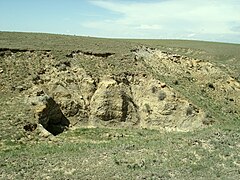| Laramie Formation | |
|---|---|
| Stratigraphic range: Maastrichtian, 69–68 Ma | |
 | |
| Type | Geological formation |
| Underlies | Arapahoe Formation |
| Overlies | Fox Hills Formation |
| Thickness | 200-400 ft (60-120 m) |
| Lithology | |
| Primary | Sandstone, mudstone, clay, coal[1] |
| Location | |
| Region | Colorado |
| Country | United States |
| Type section | |
| Named by | Clarence King[2] |
The Laramie Formation is a geologic formation of the Late Cretaceous (Maastrichtian) age, named by Clarence King in 1876 for exposures in northeastern Colorado, in the United States.[2] It was deposited on a coastal plain and in coastal swamps that flanked the Western Interior Seaway.[3] It contains coal, clay and uranium deposits, as well as plant and animal fossils, including dinosaur remains.[1] The formation contains some of the oldest records of Grass in western North America.[4]
- ^ a b U.S. Geological Survey. "Geologic Unit: Laramie". Retrieved 2014-12-27.
- ^ a b King, C. 1876. Report of the Geological Exploration of the Fortieth Parallel. U.S.Geographical and Geological Survey.
- ^ Cite error: The named reference
SDwas invoked but never defined (see the help page). - ^ "F. H. Knowlton. 1899. Fossil Flora of the Yellowstone National Park. USGS Monograph Series". PBDB.org.